Cyber Law Case Analysis: Tiffany v. eBay and A.V. v. iParadigms Cases
VerifiedAdded on 2022/11/27
|6
|1420
|254
Case Study
AI Summary
This document provides a detailed analysis of two significant cyber law cases: Tiffany (NJ) Inc. v. eBay Inc. and A.V. v. iParadigms, L.L.C. The Tiffany v. eBay case involves trademark infringement, false advertising, and trademark dilution, focusing on eBay's role in facilitating the sale of counterfeit Tiffany jewelry. The analysis covers the facts, legal issues, arguments from both sides, and applicable laws, concluding with the court's findings. The A.V. v. iParadigms case concerns copyright and fair use, specifically addressing whether the digital archiving of student papers for plagiarism detection constitutes fair use. The analysis includes the facts, legal arguments, and the application of relevant laws like the Computer Fraud and Abuse Act, ultimately concluding with the court's decision on fair use. Both case studies follow the provided assignment brief, including facts, issues, arguments, applicable laws, and conclusions, supported by peer-reviewed scholarly references in APA format.
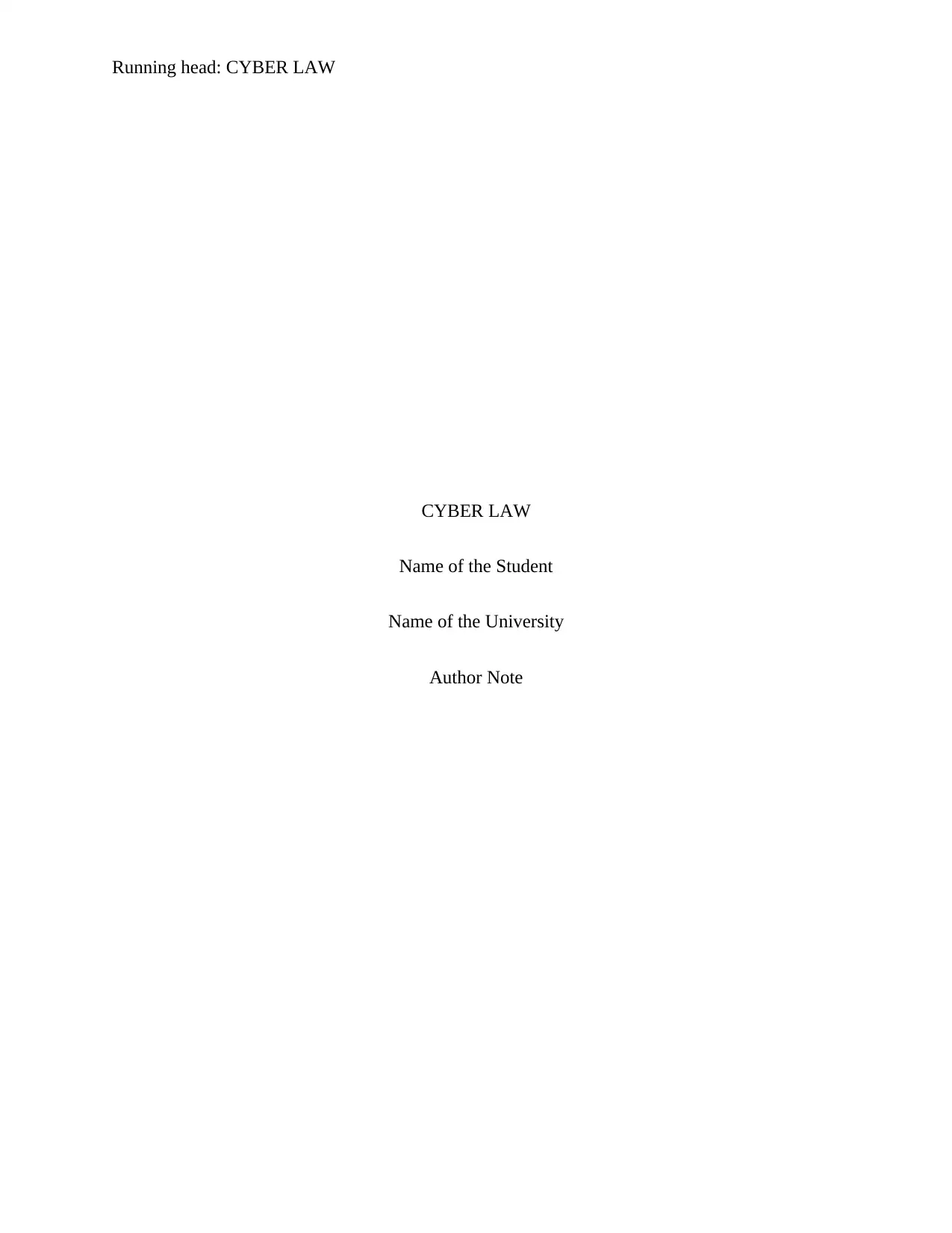
Running head: CYBER LAW
CYBER LAW
Name of the Student
Name of the University
Author Note
CYBER LAW
Name of the Student
Name of the University
Author Note
Paraphrase This Document
Need a fresh take? Get an instant paraphrase of this document with our AI Paraphraser
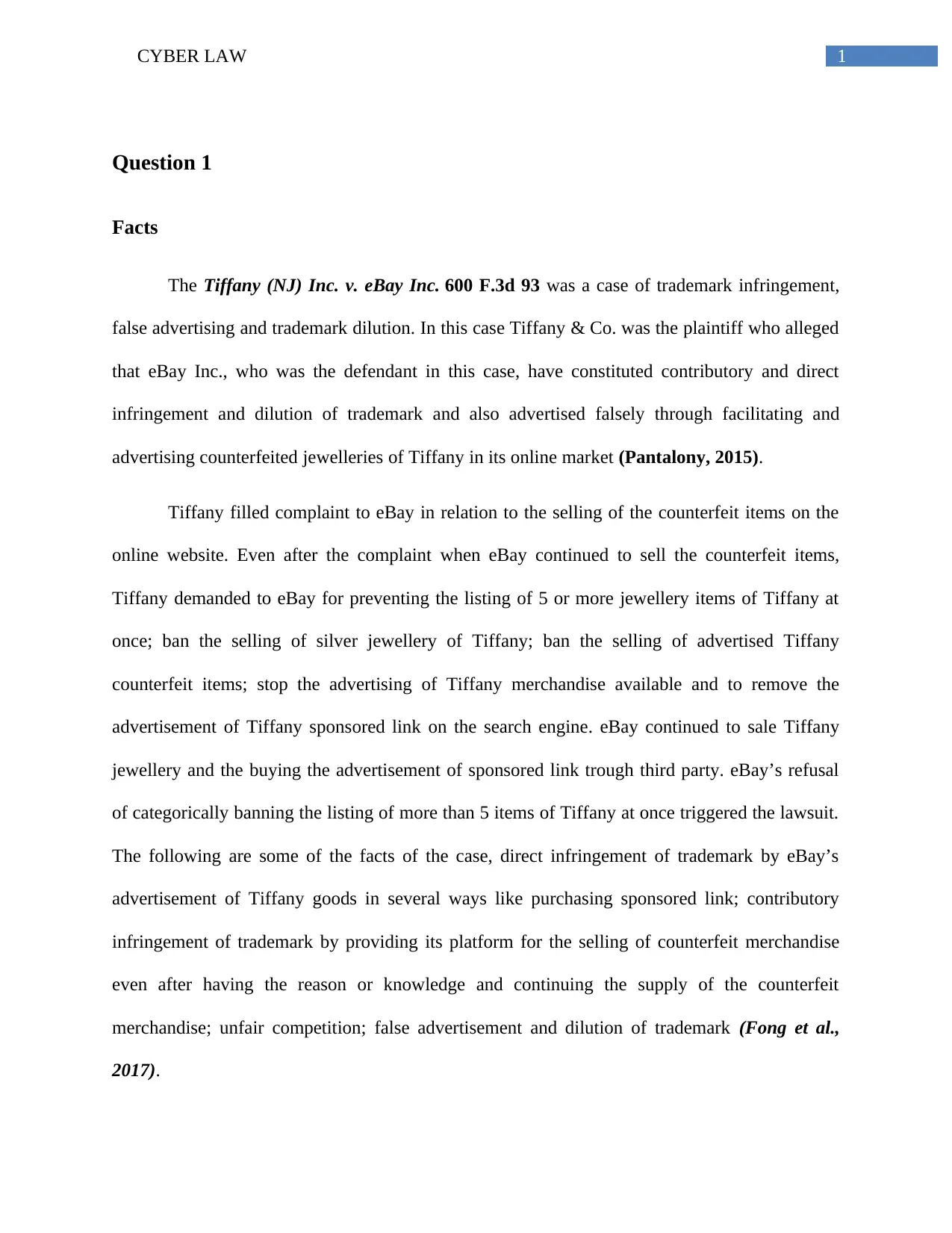
1CYBER LAW
Question 1
Facts
The Tiffany (NJ) Inc. v. eBay Inc. 600 F.3d 93 was a case of trademark infringement,
false advertising and trademark dilution. In this case Tiffany & Co. was the plaintiff who alleged
that eBay Inc., who was the defendant in this case, have constituted contributory and direct
infringement and dilution of trademark and also advertised falsely through facilitating and
advertising counterfeited jewelleries of Tiffany in its online market (Pantalony, 2015).
Tiffany filled complaint to eBay in relation to the selling of the counterfeit items on the
online website. Even after the complaint when eBay continued to sell the counterfeit items,
Tiffany demanded to eBay for preventing the listing of 5 or more jewellery items of Tiffany at
once; ban the selling of silver jewellery of Tiffany; ban the selling of advertised Tiffany
counterfeit items; stop the advertising of Tiffany merchandise available and to remove the
advertisement of Tiffany sponsored link on the search engine. eBay continued to sale Tiffany
jewellery and the buying the advertisement of sponsored link trough third party. eBay’s refusal
of categorically banning the listing of more than 5 items of Tiffany at once triggered the lawsuit.
The following are some of the facts of the case, direct infringement of trademark by eBay’s
advertisement of Tiffany goods in several ways like purchasing sponsored link; contributory
infringement of trademark by providing its platform for the selling of counterfeit merchandise
even after having the reason or knowledge and continuing the supply of the counterfeit
merchandise; unfair competition; false advertisement and dilution of trademark (Fong et al.,
2017).
Question 1
Facts
The Tiffany (NJ) Inc. v. eBay Inc. 600 F.3d 93 was a case of trademark infringement,
false advertising and trademark dilution. In this case Tiffany & Co. was the plaintiff who alleged
that eBay Inc., who was the defendant in this case, have constituted contributory and direct
infringement and dilution of trademark and also advertised falsely through facilitating and
advertising counterfeited jewelleries of Tiffany in its online market (Pantalony, 2015).
Tiffany filled complaint to eBay in relation to the selling of the counterfeit items on the
online website. Even after the complaint when eBay continued to sell the counterfeit items,
Tiffany demanded to eBay for preventing the listing of 5 or more jewellery items of Tiffany at
once; ban the selling of silver jewellery of Tiffany; ban the selling of advertised Tiffany
counterfeit items; stop the advertising of Tiffany merchandise available and to remove the
advertisement of Tiffany sponsored link on the search engine. eBay continued to sale Tiffany
jewellery and the buying the advertisement of sponsored link trough third party. eBay’s refusal
of categorically banning the listing of more than 5 items of Tiffany at once triggered the lawsuit.
The following are some of the facts of the case, direct infringement of trademark by eBay’s
advertisement of Tiffany goods in several ways like purchasing sponsored link; contributory
infringement of trademark by providing its platform for the selling of counterfeit merchandise
even after having the reason or knowledge and continuing the supply of the counterfeit
merchandise; unfair competition; false advertisement and dilution of trademark (Fong et al.,
2017).
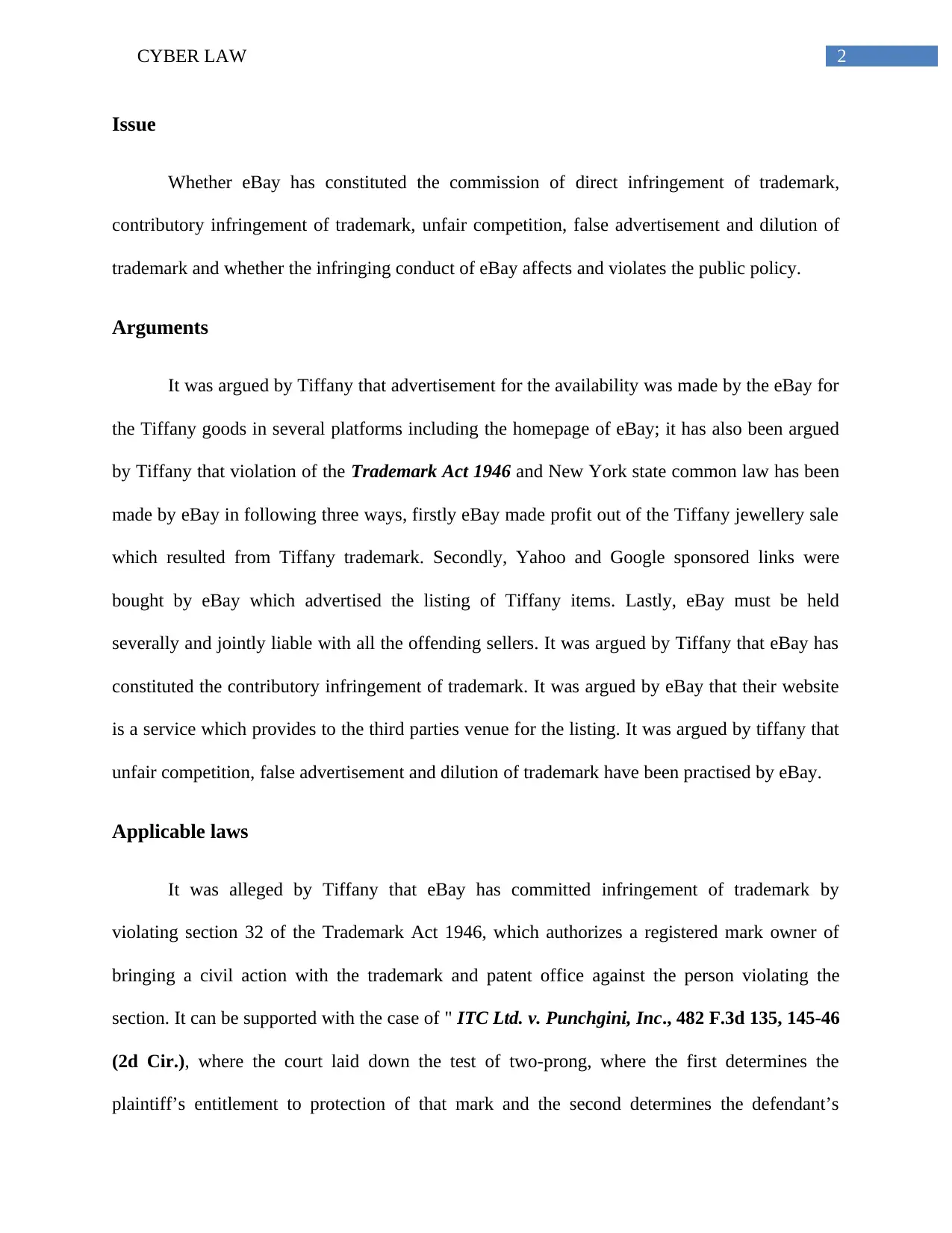
2CYBER LAW
Issue
Whether eBay has constituted the commission of direct infringement of trademark,
contributory infringement of trademark, unfair competition, false advertisement and dilution of
trademark and whether the infringing conduct of eBay affects and violates the public policy.
Arguments
It was argued by Tiffany that advertisement for the availability was made by the eBay for
the Tiffany goods in several platforms including the homepage of eBay; it has also been argued
by Tiffany that violation of the Trademark Act 1946 and New York state common law has been
made by eBay in following three ways, firstly eBay made profit out of the Tiffany jewellery sale
which resulted from Tiffany trademark. Secondly, Yahoo and Google sponsored links were
bought by eBay which advertised the listing of Tiffany items. Lastly, eBay must be held
severally and jointly liable with all the offending sellers. It was argued by Tiffany that eBay has
constituted the contributory infringement of trademark. It was argued by eBay that their website
is a service which provides to the third parties venue for the listing. It was argued by tiffany that
unfair competition, false advertisement and dilution of trademark have been practised by eBay.
Applicable laws
It was alleged by Tiffany that eBay has committed infringement of trademark by
violating section 32 of the Trademark Act 1946, which authorizes a registered mark owner of
bringing a civil action with the trademark and patent office against the person violating the
section. It can be supported with the case of " ITC Ltd. v. Punchgini, Inc., 482 F.3d 135, 145-46
(2d Cir.), where the court laid down the test of two-prong, where the first determines the
plaintiff’s entitlement to protection of that mark and the second determines the defendant’s
Issue
Whether eBay has constituted the commission of direct infringement of trademark,
contributory infringement of trademark, unfair competition, false advertisement and dilution of
trademark and whether the infringing conduct of eBay affects and violates the public policy.
Arguments
It was argued by Tiffany that advertisement for the availability was made by the eBay for
the Tiffany goods in several platforms including the homepage of eBay; it has also been argued
by Tiffany that violation of the Trademark Act 1946 and New York state common law has been
made by eBay in following three ways, firstly eBay made profit out of the Tiffany jewellery sale
which resulted from Tiffany trademark. Secondly, Yahoo and Google sponsored links were
bought by eBay which advertised the listing of Tiffany items. Lastly, eBay must be held
severally and jointly liable with all the offending sellers. It was argued by Tiffany that eBay has
constituted the contributory infringement of trademark. It was argued by eBay that their website
is a service which provides to the third parties venue for the listing. It was argued by tiffany that
unfair competition, false advertisement and dilution of trademark have been practised by eBay.
Applicable laws
It was alleged by Tiffany that eBay has committed infringement of trademark by
violating section 32 of the Trademark Act 1946, which authorizes a registered mark owner of
bringing a civil action with the trademark and patent office against the person violating the
section. It can be supported with the case of " ITC Ltd. v. Punchgini, Inc., 482 F.3d 135, 145-46
(2d Cir.), where the court laid down the test of two-prong, where the first determines the
plaintiff’s entitlement to protection of that mark and the second determines the defendant’s
⊘ This is a preview!⊘
Do you want full access?
Subscribe today to unlock all pages.

Trusted by 1+ million students worldwide
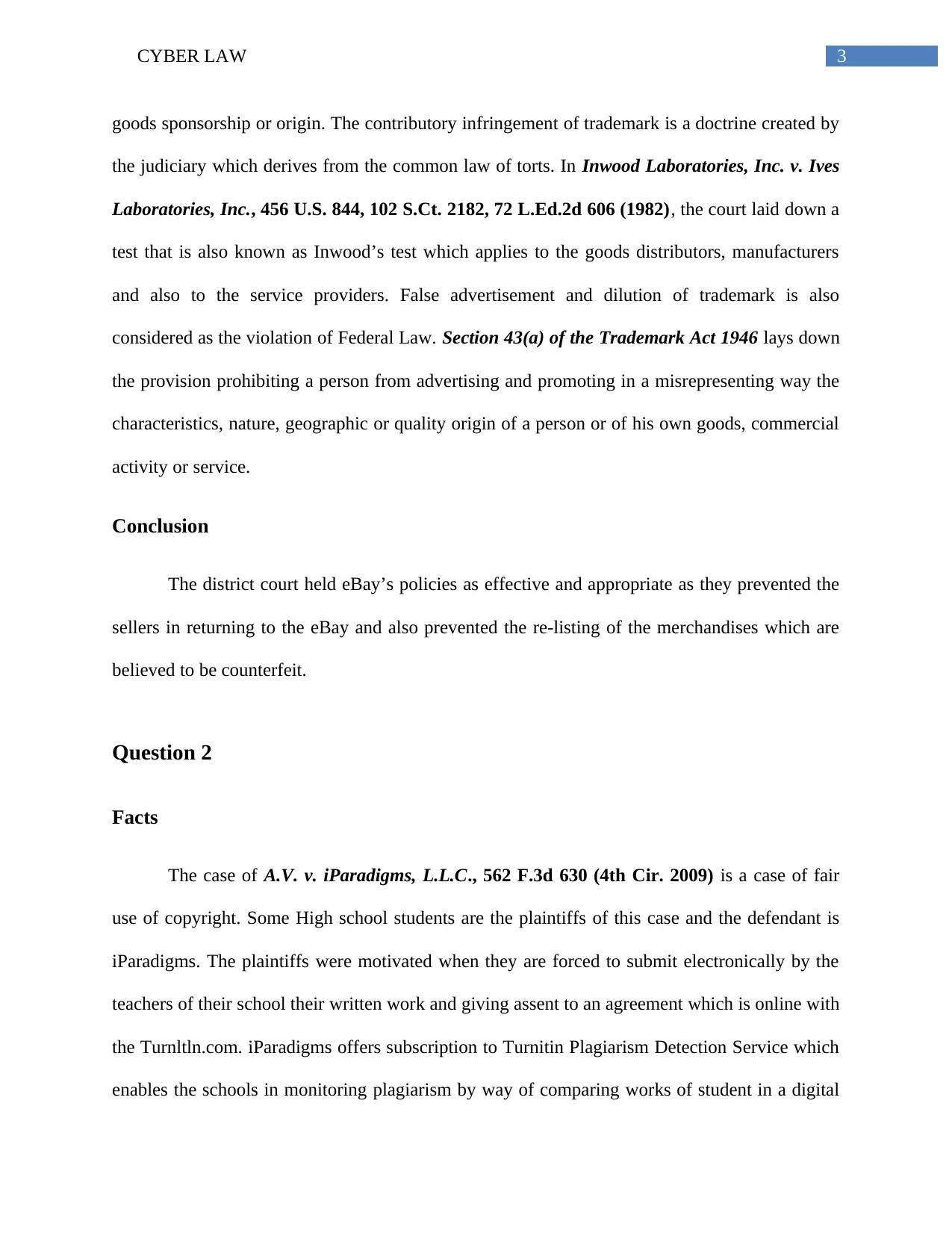
3CYBER LAW
goods sponsorship or origin. The contributory infringement of trademark is a doctrine created by
the judiciary which derives from the common law of torts. In Inwood Laboratories, Inc. v. Ives
Laboratories, Inc., 456 U.S. 844, 102 S.Ct. 2182, 72 L.Ed.2d 606 (1982), the court laid down a
test that is also known as Inwood’s test which applies to the goods distributors, manufacturers
and also to the service providers. False advertisement and dilution of trademark is also
considered as the violation of Federal Law. Section 43(a) of the Trademark Act 1946 lays down
the provision prohibiting a person from advertising and promoting in a misrepresenting way the
characteristics, nature, geographic or quality origin of a person or of his own goods, commercial
activity or service.
Conclusion
The district court held eBay’s policies as effective and appropriate as they prevented the
sellers in returning to the eBay and also prevented the re-listing of the merchandises which are
believed to be counterfeit.
Question 2
Facts
The case of A.V. v. iParadigms, L.L.C., 562 F.3d 630 (4th Cir. 2009) is a case of fair
use of copyright. Some High school students are the plaintiffs of this case and the defendant is
iParadigms. The plaintiffs were motivated when they are forced to submit electronically by the
teachers of their school their written work and giving assent to an agreement which is online with
the Turnltln.com. iParadigms offers subscription to Turnitin Plagiarism Detection Service which
enables the schools in monitoring plagiarism by way of comparing works of student in a digital
goods sponsorship or origin. The contributory infringement of trademark is a doctrine created by
the judiciary which derives from the common law of torts. In Inwood Laboratories, Inc. v. Ives
Laboratories, Inc., 456 U.S. 844, 102 S.Ct. 2182, 72 L.Ed.2d 606 (1982), the court laid down a
test that is also known as Inwood’s test which applies to the goods distributors, manufacturers
and also to the service providers. False advertisement and dilution of trademark is also
considered as the violation of Federal Law. Section 43(a) of the Trademark Act 1946 lays down
the provision prohibiting a person from advertising and promoting in a misrepresenting way the
characteristics, nature, geographic or quality origin of a person or of his own goods, commercial
activity or service.
Conclusion
The district court held eBay’s policies as effective and appropriate as they prevented the
sellers in returning to the eBay and also prevented the re-listing of the merchandises which are
believed to be counterfeit.
Question 2
Facts
The case of A.V. v. iParadigms, L.L.C., 562 F.3d 630 (4th Cir. 2009) is a case of fair
use of copyright. Some High school students are the plaintiffs of this case and the defendant is
iParadigms. The plaintiffs were motivated when they are forced to submit electronically by the
teachers of their school their written work and giving assent to an agreement which is online with
the Turnltln.com. iParadigms offers subscription to Turnitin Plagiarism Detection Service which
enables the schools in monitoring plagiarism by way of comparing works of student in a digital
Paraphrase This Document
Need a fresh take? Get an instant paraphrase of this document with our AI Paraphraser
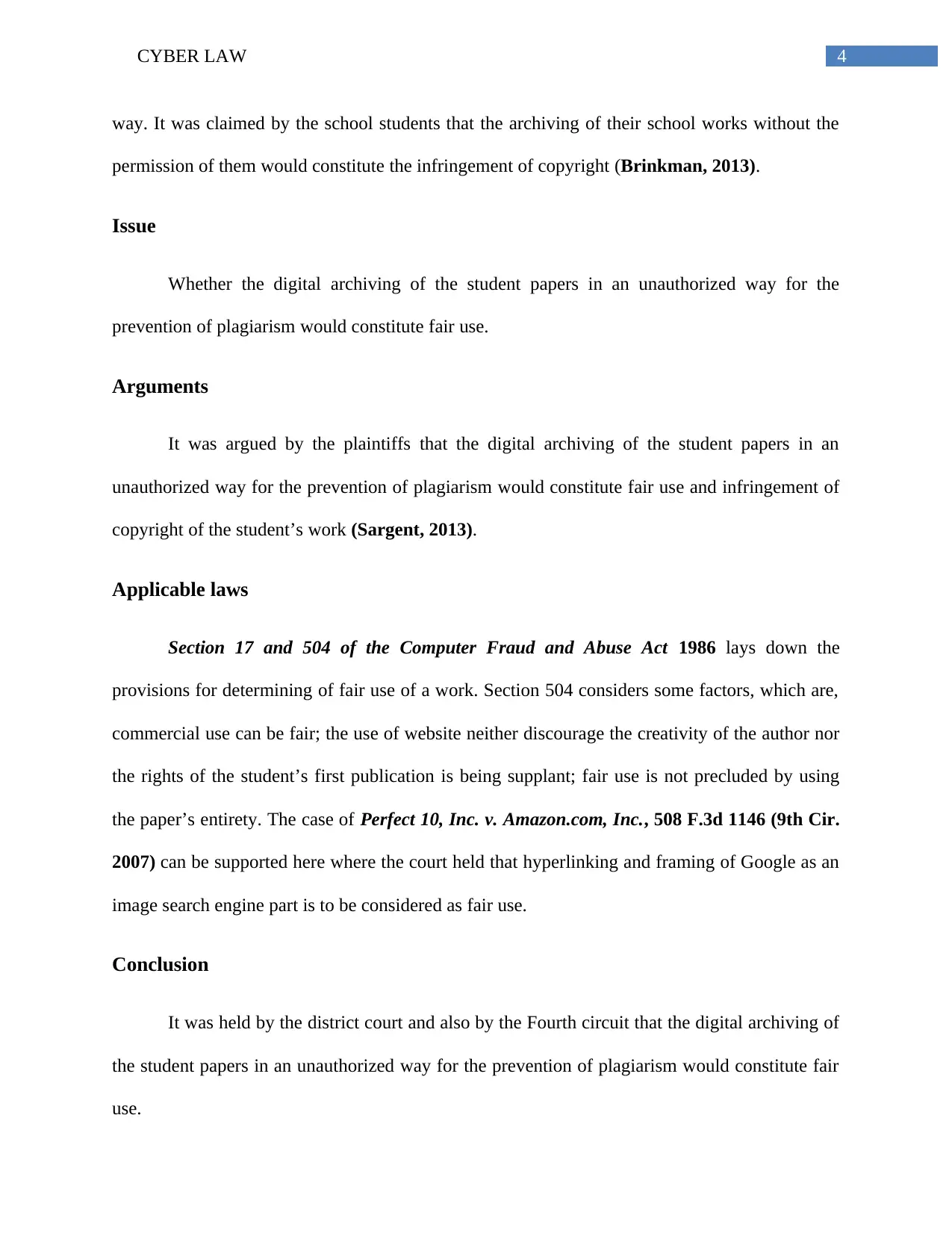
4CYBER LAW
way. It was claimed by the school students that the archiving of their school works without the
permission of them would constitute the infringement of copyright (Brinkman, 2013).
Issue
Whether the digital archiving of the student papers in an unauthorized way for the
prevention of plagiarism would constitute fair use.
Arguments
It was argued by the plaintiffs that the digital archiving of the student papers in an
unauthorized way for the prevention of plagiarism would constitute fair use and infringement of
copyright of the student’s work (Sargent, 2013).
Applicable laws
Section 17 and 504 of the Computer Fraud and Abuse Act 1986 lays down the
provisions for determining of fair use of a work. Section 504 considers some factors, which are,
commercial use can be fair; the use of website neither discourage the creativity of the author nor
the rights of the student’s first publication is being supplant; fair use is not precluded by using
the paper’s entirety. The case of Perfect 10, Inc. v. Amazon.com, Inc., 508 F.3d 1146 (9th Cir.
2007) can be supported here where the court held that hyperlinking and framing of Google as an
image search engine part is to be considered as fair use.
Conclusion
It was held by the district court and also by the Fourth circuit that the digital archiving of
the student papers in an unauthorized way for the prevention of plagiarism would constitute fair
use.
way. It was claimed by the school students that the archiving of their school works without the
permission of them would constitute the infringement of copyright (Brinkman, 2013).
Issue
Whether the digital archiving of the student papers in an unauthorized way for the
prevention of plagiarism would constitute fair use.
Arguments
It was argued by the plaintiffs that the digital archiving of the student papers in an
unauthorized way for the prevention of plagiarism would constitute fair use and infringement of
copyright of the student’s work (Sargent, 2013).
Applicable laws
Section 17 and 504 of the Computer Fraud and Abuse Act 1986 lays down the
provisions for determining of fair use of a work. Section 504 considers some factors, which are,
commercial use can be fair; the use of website neither discourage the creativity of the author nor
the rights of the student’s first publication is being supplant; fair use is not precluded by using
the paper’s entirety. The case of Perfect 10, Inc. v. Amazon.com, Inc., 508 F.3d 1146 (9th Cir.
2007) can be supported here where the court held that hyperlinking and framing of Google as an
image search engine part is to be considered as fair use.
Conclusion
It was held by the district court and also by the Fourth circuit that the digital archiving of
the student papers in an unauthorized way for the prevention of plagiarism would constitute fair
use.
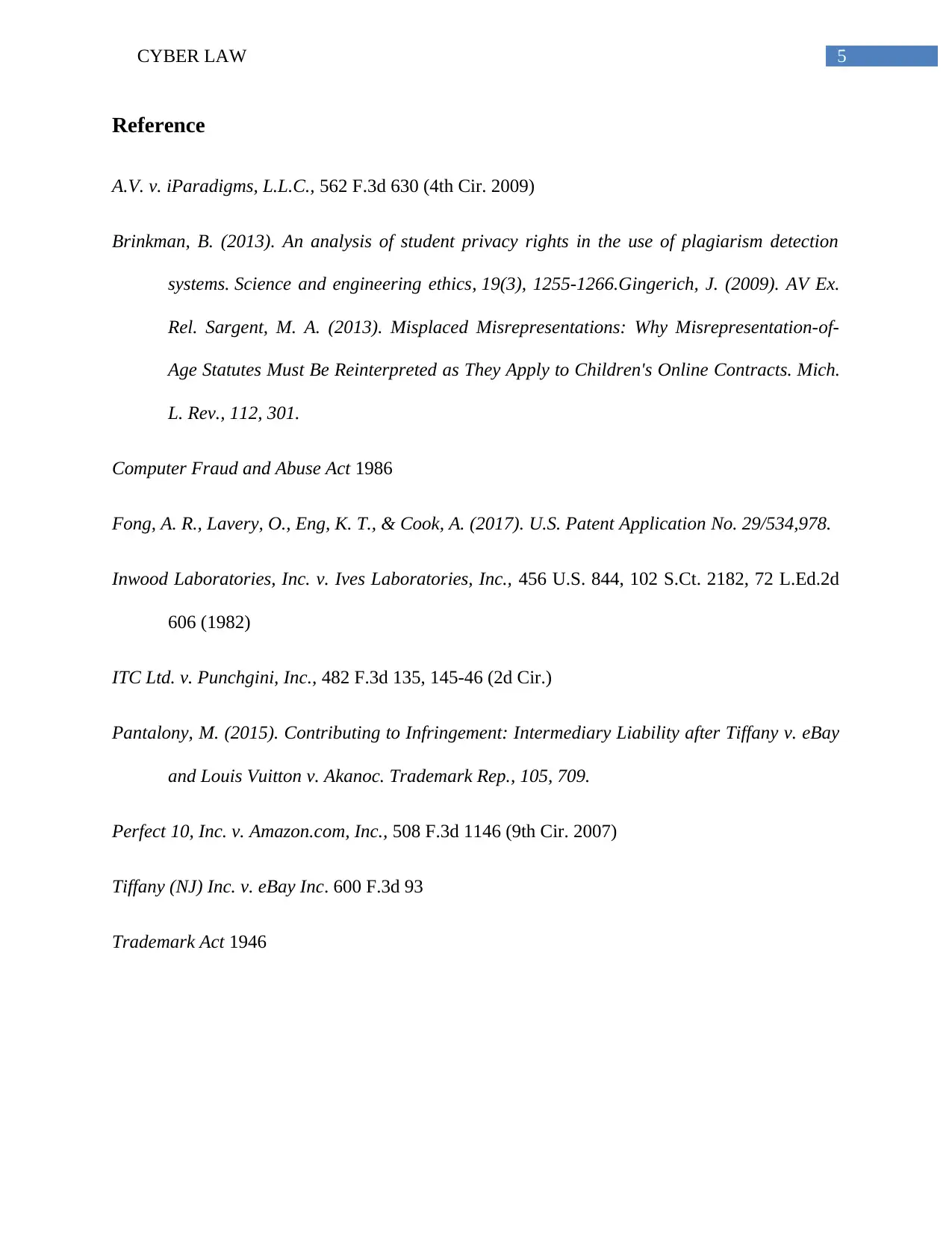
5CYBER LAW
Reference
A.V. v. iParadigms, L.L.C., 562 F.3d 630 (4th Cir. 2009)
Brinkman, B. (2013). An analysis of student privacy rights in the use of plagiarism detection
systems. Science and engineering ethics, 19(3), 1255-1266.Gingerich, J. (2009). AV Ex.
Rel. Sargent, M. A. (2013). Misplaced Misrepresentations: Why Misrepresentation-of-
Age Statutes Must Be Reinterpreted as They Apply to Children's Online Contracts. Mich.
L. Rev., 112, 301.
Computer Fraud and Abuse Act 1986
Fong, A. R., Lavery, O., Eng, K. T., & Cook, A. (2017). U.S. Patent Application No. 29/534,978.
Inwood Laboratories, Inc. v. Ives Laboratories, Inc., 456 U.S. 844, 102 S.Ct. 2182, 72 L.Ed.2d
606 (1982)
ITC Ltd. v. Punchgini, Inc., 482 F.3d 135, 145-46 (2d Cir.)
Pantalony, M. (2015). Contributing to Infringement: Intermediary Liability after Tiffany v. eBay
and Louis Vuitton v. Akanoc. Trademark Rep., 105, 709.
Perfect 10, Inc. v. Amazon.com, Inc., 508 F.3d 1146 (9th Cir. 2007)
Tiffany (NJ) Inc. v. eBay Inc. 600 F.3d 93
Trademark Act 1946
Reference
A.V. v. iParadigms, L.L.C., 562 F.3d 630 (4th Cir. 2009)
Brinkman, B. (2013). An analysis of student privacy rights in the use of plagiarism detection
systems. Science and engineering ethics, 19(3), 1255-1266.Gingerich, J. (2009). AV Ex.
Rel. Sargent, M. A. (2013). Misplaced Misrepresentations: Why Misrepresentation-of-
Age Statutes Must Be Reinterpreted as They Apply to Children's Online Contracts. Mich.
L. Rev., 112, 301.
Computer Fraud and Abuse Act 1986
Fong, A. R., Lavery, O., Eng, K. T., & Cook, A. (2017). U.S. Patent Application No. 29/534,978.
Inwood Laboratories, Inc. v. Ives Laboratories, Inc., 456 U.S. 844, 102 S.Ct. 2182, 72 L.Ed.2d
606 (1982)
ITC Ltd. v. Punchgini, Inc., 482 F.3d 135, 145-46 (2d Cir.)
Pantalony, M. (2015). Contributing to Infringement: Intermediary Liability after Tiffany v. eBay
and Louis Vuitton v. Akanoc. Trademark Rep., 105, 709.
Perfect 10, Inc. v. Amazon.com, Inc., 508 F.3d 1146 (9th Cir. 2007)
Tiffany (NJ) Inc. v. eBay Inc. 600 F.3d 93
Trademark Act 1946
⊘ This is a preview!⊘
Do you want full access?
Subscribe today to unlock all pages.

Trusted by 1+ million students worldwide
1 out of 6
Your All-in-One AI-Powered Toolkit for Academic Success.
+13062052269
info@desklib.com
Available 24*7 on WhatsApp / Email
![[object Object]](/_next/static/media/star-bottom.7253800d.svg)
Unlock your academic potential
Copyright © 2020–2025 A2Z Services. All Rights Reserved. Developed and managed by ZUCOL.